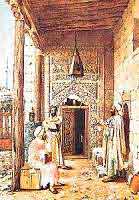|
|
|
PAINTING |
"At the gate of Karaman Medresse" by Osman Hamdi Bey Painting in the western sense started to develop in Turkey in the nineteenth century. Artists such as Namik Ismail, Ibrahim Calli, Avni Lifij, Feyheman Duran and Hikmet Onat, who had their art education in Europe in the 1910s, became impressionists. These artists, who are known as the 1914 Generation , influenced the development of painting in the early Republic Period. Extensive research carried out by Public Centers (Halkevleri) on Anatolian peoples' art and culture in the 1930s influenced many artists and caused them to deal with the issues raised in the wake of the findings of the research. In this period, the D Group, established by Zeki Faik Izer, Nurullah Berk, Elif Naci, Cemal Tollu, Abidin Dino and sculptor Zuhtu Muridoglu, ignored the impressionist tendencies and set out to create a joint language, and sought to achieve a synthesis between certain elements of traditional Turkish art and the ideas of the new art movements in Europe, between local color and western techniques and between domestic "soul" and the universal artistic ideals. Within the art and culture development program, which gained momentum after the 1930s, the Academy of Fine Arts in Istanbul, which was called Sanayi-i Nefise Mektebi until 1936, was restructured. It was taken under the structure of the Ministry of National Education. A French artist, Leopold Levy, was appointed as the chairman of the painting department between 1949 and 1950. Levy's students founded a group aptly called the Yeniler Grubu (The New Group) which was the most important group in the field of painting after the D Group and which experimented with new styles and new techniques. The members of this group, who continued exhibitions until 1955, were focused on social issues in the beginning, but later distanced themselves from the social-realistic manner of expression. In the 1950s, when the art movements were followed more closely, the first abstract painters emerged in Turkey. Among these are Adnan Coker, Lutfu Gunay, Semsi Arel, Abidin Elderoglu and Sabri Berkel who tried to give a traditional and local touch to abstract forms by using calligraphy. Neset Gunal's paintings on social issues, the miniature-like paintings of Devrim Erbil, Cihat Burak's paintings which have traces from folk art, the animal figures and Anatolian landscapes of Orhan Peker which he painted with staining techniques, are all examples of the diversity of figurative tendencies in the 1960s and the 1970s. By the 1970s, many artists managed to reach some synthesis between the competing tendencies such as abstract-figurative and universal-domestic. Meanwhile pioneering and experimental works were supported by the annual exhibition "New Tendencies" held within the framework of the Istanbul Art Festival, which was first organized in 1977. Since 1980, conceptual art works are also common along with the traditional paintings on canvas. |
